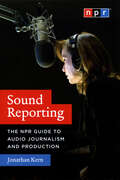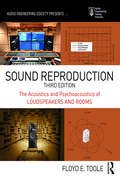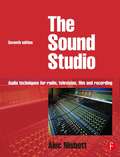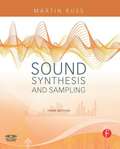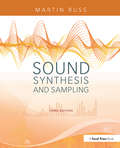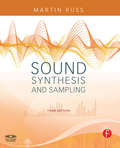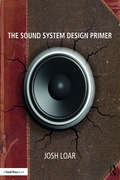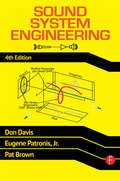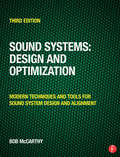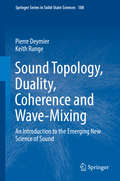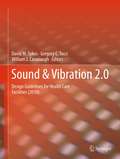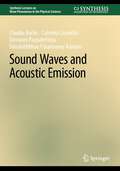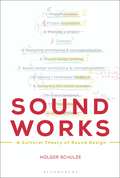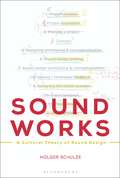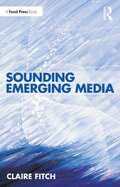- Table View
- List View
Sound Reporting: The NPR Guide to Audio Journalism and Production
by Jonathan KernPerhaps you’ve always wondered how public radio gets that smooth, well-crafted sound. Maybe you’re thinking about starting a podcast, and want some tips from the pros. Or maybe storytelling has always been a passion of yours, and you want to learn to do it more effectively. Whatever the case—whether you’re an avid NPR listener or you aspire to create your own audio, or both—Sound Reporting: The NPR Guide to Audio Journalism and Production will give you a rare tour of the world of a professional broadcaster. Jonathan Kern, who has trained NPR’s on-air staff for years, is a gifted guide, able to narrate a day in the life of a host and lay out the nuts and bolts of production with equal wit and warmth. Along the way, he explains the importance of writing the way you speak, reveals how NPR books guests ranging from world leaders to neighborhood newsmakers, and gives sage advice on everything from proposing stories to editors to maintaining balance and objectivity. Best of all—because NPR wouldn’t be NPR without its array of distinctive voices—lively examples from popular shows and colorful anecdotes from favorite personalities animate each chapter. As public radio’s audience of millions can attest, NPR’s unique guiding principles and technical expertise combine to connect with listeners like no other medium can. With today’s technologies allowing more people to turn their home computers into broadcast studios, Sound Reporting couldn’t have arrived at a better moment to reveal the secrets behind the story of NPR’s success.
Sound Reporting: The NPR Guide to Audio Journalism and Production
by Jonathan KernPerhaps you’ve always wondered how public radio gets that smooth, well-crafted sound. Maybe you’re thinking about starting a podcast, and want some tips from the pros. Or maybe storytelling has always been a passion of yours, and you want to learn to do it more effectively. Whatever the case—whether you’re an avid NPR listener or you aspire to create your own audio, or both—Sound Reporting: The NPR Guide to Audio Journalism and Production will give you a rare tour of the world of a professional broadcaster. Jonathan Kern, who has trained NPR’s on-air staff for years, is a gifted guide, able to narrate a day in the life of a host and lay out the nuts and bolts of production with equal wit and warmth. Along the way, he explains the importance of writing the way you speak, reveals how NPR books guests ranging from world leaders to neighborhood newsmakers, and gives sage advice on everything from proposing stories to editors to maintaining balance and objectivity. Best of all—because NPR wouldn’t be NPR without its array of distinctive voices—lively examples from popular shows and colorful anecdotes from favorite personalities animate each chapter. As public radio’s audience of millions can attest, NPR’s unique guiding principles and technical expertise combine to connect with listeners like no other medium can. With today’s technologies allowing more people to turn their home computers into broadcast studios, Sound Reporting couldn’t have arrived at a better moment to reveal the secrets behind the story of NPR’s success.
Sound Reporting: The NPR Guide to Audio Journalism and Production
by Jonathan KernPerhaps you’ve always wondered how public radio gets that smooth, well-crafted sound. Maybe you’re thinking about starting a podcast, and want some tips from the pros. Or maybe storytelling has always been a passion of yours, and you want to learn to do it more effectively. Whatever the case—whether you’re an avid NPR listener or you aspire to create your own audio, or both—Sound Reporting: The NPR Guide to Audio Journalism and Production will give you a rare tour of the world of a professional broadcaster. Jonathan Kern, who has trained NPR’s on-air staff for years, is a gifted guide, able to narrate a day in the life of a host and lay out the nuts and bolts of production with equal wit and warmth. Along the way, he explains the importance of writing the way you speak, reveals how NPR books guests ranging from world leaders to neighborhood newsmakers, and gives sage advice on everything from proposing stories to editors to maintaining balance and objectivity. Best of all—because NPR wouldn’t be NPR without its array of distinctive voices—lively examples from popular shows and colorful anecdotes from favorite personalities animate each chapter. As public radio’s audience of millions can attest, NPR’s unique guiding principles and technical expertise combine to connect with listeners like no other medium can. With today’s technologies allowing more people to turn their home computers into broadcast studios, Sound Reporting couldn’t have arrived at a better moment to reveal the secrets behind the story of NPR’s success.
Sound Reporting: The NPR Guide to Audio Journalism and Production
by Jonathan KernPerhaps you’ve always wondered how public radio gets that smooth, well-crafted sound. Maybe you’re thinking about starting a podcast, and want some tips from the pros. Or maybe storytelling has always been a passion of yours, and you want to learn to do it more effectively. Whatever the case—whether you’re an avid NPR listener or you aspire to create your own audio, or both—Sound Reporting: The NPR Guide to Audio Journalism and Production will give you a rare tour of the world of a professional broadcaster. Jonathan Kern, who has trained NPR’s on-air staff for years, is a gifted guide, able to narrate a day in the life of a host and lay out the nuts and bolts of production with equal wit and warmth. Along the way, he explains the importance of writing the way you speak, reveals how NPR books guests ranging from world leaders to neighborhood newsmakers, and gives sage advice on everything from proposing stories to editors to maintaining balance and objectivity. Best of all—because NPR wouldn’t be NPR without its array of distinctive voices—lively examples from popular shows and colorful anecdotes from favorite personalities animate each chapter. As public radio’s audience of millions can attest, NPR’s unique guiding principles and technical expertise combine to connect with listeners like no other medium can. With today’s technologies allowing more people to turn their home computers into broadcast studios, Sound Reporting couldn’t have arrived at a better moment to reveal the secrets behind the story of NPR’s success.
Sound Reporting: The NPR Guide to Audio Journalism and Production
by Jonathan KernPerhaps you’ve always wondered how public radio gets that smooth, well-crafted sound. Maybe you’re thinking about starting a podcast, and want some tips from the pros. Or maybe storytelling has always been a passion of yours, and you want to learn to do it more effectively. Whatever the case—whether you’re an avid NPR listener or you aspire to create your own audio, or both—Sound Reporting: The NPR Guide to Audio Journalism and Production will give you a rare tour of the world of a professional broadcaster. Jonathan Kern, who has trained NPR’s on-air staff for years, is a gifted guide, able to narrate a day in the life of a host and lay out the nuts and bolts of production with equal wit and warmth. Along the way, he explains the importance of writing the way you speak, reveals how NPR books guests ranging from world leaders to neighborhood newsmakers, and gives sage advice on everything from proposing stories to editors to maintaining balance and objectivity. Best of all—because NPR wouldn’t be NPR without its array of distinctive voices—lively examples from popular shows and colorful anecdotes from favorite personalities animate each chapter. As public radio’s audience of millions can attest, NPR’s unique guiding principles and technical expertise combine to connect with listeners like no other medium can. With today’s technologies allowing more people to turn their home computers into broadcast studios, Sound Reporting couldn’t have arrived at a better moment to reveal the secrets behind the story of NPR’s success.
Sound Reporting: The NPR Guide to Audio Journalism and Production
by Jonathan KernPerhaps you’ve always wondered how public radio gets that smooth, well-crafted sound. Maybe you’re thinking about starting a podcast, and want some tips from the pros. Or maybe storytelling has always been a passion of yours, and you want to learn to do it more effectively. Whatever the case—whether you’re an avid NPR listener or you aspire to create your own audio, or both—Sound Reporting: The NPR Guide to Audio Journalism and Production will give you a rare tour of the world of a professional broadcaster. Jonathan Kern, who has trained NPR’s on-air staff for years, is a gifted guide, able to narrate a day in the life of a host and lay out the nuts and bolts of production with equal wit and warmth. Along the way, he explains the importance of writing the way you speak, reveals how NPR books guests ranging from world leaders to neighborhood newsmakers, and gives sage advice on everything from proposing stories to editors to maintaining balance and objectivity. Best of all—because NPR wouldn’t be NPR without its array of distinctive voices—lively examples from popular shows and colorful anecdotes from favorite personalities animate each chapter. As public radio’s audience of millions can attest, NPR’s unique guiding principles and technical expertise combine to connect with listeners like no other medium can. With today’s technologies allowing more people to turn their home computers into broadcast studios, Sound Reporting couldn’t have arrived at a better moment to reveal the secrets behind the story of NPR’s success.
Sound Reproduction: The Acoustics and Psychoacoustics of Loudspeakers and Rooms (Audio Engineering Society Presents)
by Floyd E. TooleSound Reproduction: The Acoustics and Psychoacoustics of Loudspeakers and Rooms, Third Edition explains the physical and perceptual processes that are involved in sound reproduction and demonstrates how to use the processes to create high-quality listening experiences in stereo and multichannel formats. Understanding the principles of sound production is necessary to achieve the goals of sound reproduction in spaces ranging from recording control rooms and home listening rooms to large cinemas. This revision brings new science-based perspectives on the performance of loudspeakers, room acoustics, measurements and equalization, all of which need to be appropriately used to ensure the accurate delivery of music and movie sound tracks from creators to listeners. The robust website (www.routledge.com/cw/toole) is the perfect companion to this necessary resource.
Sound Reproduction: The Acoustics and Psychoacoustics of Loudspeakers and Rooms (Audio Engineering Society Presents)
by Floyd E. TooleSound Reproduction: The Acoustics and Psychoacoustics of Loudspeakers and Rooms, Third Edition explains the physical and perceptual processes that are involved in sound reproduction and demonstrates how to use the processes to create high-quality listening experiences in stereo and multichannel formats. Understanding the principles of sound production is necessary to achieve the goals of sound reproduction in spaces ranging from recording control rooms and home listening rooms to large cinemas. This revision brings new science-based perspectives on the performance of loudspeakers, room acoustics, measurements and equalization, all of which need to be appropriately used to ensure the accurate delivery of music and movie sound tracks from creators to listeners. The robust website (www.routledge.com/cw/toole) is the perfect companion to this necessary resource.
Sound Studio: Audio techniques for Radio, Television, Film and Recording
by Alec NisbettThis classic work has inspired and informed a whole generation of artists and technicians working in all branches of the audio industry. Now in its seventh edition, The Sound Studio has been thoroughly revised to encompass the rapidly expanding range of possibilities offered by today's digital equipment. It now covers: the virtual studio; 5.1 surround sound; hard drive mixers and multichannel recorders; DVD and CD-RW.Alec Nisbett provides encyclopaedic coverage of everything from acoustics, microphones and loudspeakers, to editing, mixing and sound effects, as well as a comprehensive glossary.Through its six previous editions, The Sound Studio has been used for over 40 years as a standard work of reference on audio techniques. For a new generation, it links all the best techniques back to their roots: the unchanging guiding principles that have long been observed over a wide range of related media and crafts. The Sound Studio is intended for anyone with a creative or technical interest in sound - for radio, television, film and music recording - but has particularly strong coverage of audio in broadcasting, reflecting the author's prolific career.
Sound Studio: Audio techniques for Radio, Television, Film and Recording (Library Of Communication Techniques Ser.)
by Alec NisbettThis classic work has inspired and informed a whole generation of artists and technicians working in all branches of the audio industry. Now in its seventh edition, The Sound Studio has been thoroughly revised to encompass the rapidly expanding range of possibilities offered by today's digital equipment. It now covers: the virtual studio; 5.1 surround sound; hard drive mixers and multichannel recorders; DVD and CD-RW.Alec Nisbett provides encyclopaedic coverage of everything from acoustics, microphones and loudspeakers, to editing, mixing and sound effects, as well as a comprehensive glossary.Through its six previous editions, The Sound Studio has been used for over 40 years as a standard work of reference on audio techniques. For a new generation, it links all the best techniques back to their roots: the unchanging guiding principles that have long been observed over a wide range of related media and crafts. The Sound Studio is intended for anyone with a creative or technical interest in sound - for radio, television, film and music recording - but has particularly strong coverage of audio in broadcasting, reflecting the author's prolific career.
Sound Synthesis And Sampling
by Martin RussSound Synthesis and Sampling' provides a comprehensive introduction to the underlying principles and practical techniques applied to both commercial and research sound synthesizers. This new edition has been updated throughout to reflect current needs and practices- revised and placed in a modern context, providing a guide to the theory of sound and sampling in the context of software and hardware that enables sound making. For the revised edition emphasis is on expanding explanations of software and computers, new sections include techniques for making sound physically, sections within analog and digital electronics. Martin Russ is well known and the book praised for its highly readable and non-mathematical approach making the subject accessible to readers starting out on computer music courses or those working in a studio.
Sound Synthesis and Sampling: An Interactive Database Of Audio Examples, Animated Diagrams, Text Notes And Multiple Choice Questions (Music Technology Ser.)
by Martin RussSound Synthesis and Sampling' provides a comprehensive introduction to the underlying principles and practical techniques applied to both commercial and research sound synthesizers. This new edition has been updated throughout to reflect current needs and practices- revised and placed in a modern context, providing a guide to the theory of sound and sampling in the context of software and hardware that enables sound making. For the revised edition emphasis is on expanding explanations of software and computers, new sections include techniques for making sound physically, sections within analog and digital electronics. Martin Russ is well known and the book praised for its highly readable and non-mathematical approach making the subject accessible to readers starting out on computer music courses or those working in a studio.
Sound Synthesis and Sampling
by Martin RussSound Synthesis and Sampling' provides a comprehensive introduction to the underlying principles and practical techniques applied to both commercial and research sound synthesizers. This new edition has been updated throughout to reflect current needs and practices- revised and placed in a modern context, providing a guide to the theory of sound and sampling in the context of software and hardware that enables sound making. For the revised edition emphasis is on expanding explanations of software and computers, new sections include techniques for making sound physically, sections within analog and digital electronics. Martin Russ is well known and the book praised for its highly readable and non-mathematical approach making the subject accessible to readers starting out on computer music courses or those working in a studio.
The Sound System Design Primer
by Josh LoarThe Sound System Design Primer is an introduction to the many topics, technologies, and sub-disciplines that make up contemporary sound systems design. Written in clear, conversational language for those who do not have an engineering background, or who think more in language than in numbers, The Sound System Design Primer provides a solid foundation in this expanding discipline for students, early/mid-career system designers, creative and content designers seeking a better grasp on the technical side of things, and non-sound professionals who want or need to be able to speak intelligently with sound system designers.
Sound System Engineering 4e
by Don Davis Eugene Patronis Pat BrownLong considered the only book an audio engineer needs on their shelf, Sound System Engineering provides an accurate, complete and concise tool for all those involved in sound system engineering. Fully updated on the design, implementation and testing of sound reinforcement systems this great reference is a necessary addition to any audio engineering library.Packed with revised material, numerous illustrations and useful appendices, this is a concentrated capsule of knowledge and industry standard that runs the complete range of sound system design from the simplest all-analog paging systems to the largest multipurpose digital systems.
Sound System Engineering 4e
by Don Davis Eugene Patronis Pat BrownLong considered the only book an audio engineer needs on their shelf, Sound System Engineering provides an accurate, complete and concise tool for all those involved in sound system engineering. Fully updated on the design, implementation and testing of sound reinforcement systems this great reference is a necessary addition to any audio engineering library.Packed with revised material, numerous illustrations and useful appendices, this is a concentrated capsule of knowledge and industry standard that runs the complete range of sound system design from the simplest all-analog paging systems to the largest multipurpose digital systems.
Sound Systems: Modern Techniques and Tools for Sound System Design and Alignment
by Bob McCarthySound Systems: Design and Optimization provides an accessible and unique perspective on the behavior of sound systems in the practical world. The third edition reflects current trends in the audio field thereby providing readers with the newest methodologies and techniques. In this greatly expanded new edition, you’ll find clearer explanations, a more streamlined organization, increased coverage of current technologies and comprehensive case studies of the author’s award-winning work in the field. As the only book devoted exclusively to modern tools and techniques in this emerging field, Sound Systems: Design and Optimization provides the specialized guidance needed to perfect your design skills. This book helps you: Improve your design and optimization decisions by understanding how audiences perceive reinforced sound Use modern analyzers and prediction programs to select speaker placement, equalization, delay and level settings based on how loudspeakers interact in the space Define speaker array configurations and design strategies that maximize the potential for spatial uniformity Gain a comprehensive understanding of the tools and techniques required to generate a design that will create a successful transmission/reception model
Sound Systems: Modern Techniques and Tools for Sound System Design and Alignment
by Bob McCarthySound Systems: Design and Optimization provides an accessible and unique perspective on the behavior of sound systems in the practical world. The third edition reflects current trends in the audio field thereby providing readers with the newest methodologies and techniques. In this greatly expanded new edition, you’ll find clearer explanations, a more streamlined organization, increased coverage of current technologies and comprehensive case studies of the author’s award-winning work in the field. As the only book devoted exclusively to modern tools and techniques in this emerging field, Sound Systems: Design and Optimization provides the specialized guidance needed to perfect your design skills. This book helps you: Improve your design and optimization decisions by understanding how audiences perceive reinforced sound Use modern analyzers and prediction programs to select speaker placement, equalization, delay and level settings based on how loudspeakers interact in the space Define speaker array configurations and design strategies that maximize the potential for spatial uniformity Gain a comprehensive understanding of the tools and techniques required to generate a design that will create a successful transmission/reception model
Sound Topology, Duality, Coherence and Wave-Mixing: An Introduction to the Emerging New Science of Sound (Springer Series in Solid-State Sciences #188)
by Pierre Deymier Keith RungeThis book offers an essential introduction to the notions of sound wave topology, duality, coherence and wave-mixing, which constitute the emerging new science of sound. It includes general principles and specific examples that illuminate new non-conventional forms of sound (sound topology), unconventional quantum-like behavior of phonons (duality), radical linear and nonlinear phenomena associated with loss and its control (coherence), and exquisite effects that emerge from the interaction of sound with other physical and biological waves (wave mixing). The book provides the reader with the foundations needed to master these complex notions through simple yet meaningful examples. General principles for unraveling and describing the topology of acoustic wave functions in the space of their Eigen values are presented. These principles are then applied to uncover intrinsic and extrinsic approaches to achieving non-conventional topologies by breaking the time reversal symmetry of acoustic waves. Symmetry breaking can impart topological immunity to wave degradation from imperfection scattering and catalyze controlled coherence. In the intrinsic case and the phonon representation of acoustic waves, the self-interaction/interference of a wave through its supporting medium exposes the notion of duality in the quantum statistics (i.e. boson vs. fermion characterized by the symmetry of multiple particle states) and how the quantum analogue behaviors of sound can be exploited in the form of novel sound-based information transfer and processing devices. By considering media that mix different types of waves, the book addresses the interaction of sound with other physical and biological waves but also brings to light examples of extrinsic processes that can lead to symmetry breaking. The coherent conversion of sound into other types of waves as well as the sound-induced non-conventional topology of elastic, electronic, spin and biological waves are presented in the case of media exhibiting elasto-electronic, photo-elastic, magneto-elastic effects and biological mechano-transduction.
Sound & Vibration 2.0: Design Guidelines for Health Care Facilities
by David Sykes William J. Cavanaugh Gregory C. TocciThis document was commissioned by the Facility Guidelines Institute as the sole reference for acoustics in health care facilities. It was written by the Health Care Acoustics Working Group, a permanent committee of the Acoustics Research Council (ARC), comprised of members of leading professional societies in acoustics, noise control engineering, acoustical consulting and related professions. ARC organized the health care Working Group in 2004-5 drawing its members from ten constituencies that range from medicine to law, public policy, architecture, design and engineering in order to provide constructive, guidance on sound and vibration based on research and best practices. Sound and Vibration 2.0 has been adopted as the sole reference standard for acoustics in health care facilities by: the 2010 FGI/ASHE "Guidelines for the Design and Construction of Healthcare Facilities" (used in 60 countries); the US Green Building Council’s "LEED for Healthcare" (used in 87 countries); The Green Guide for Health Care V2.2; and the International Code Council's IGCC (2011).Sound and vibration are topics of increasing prominence in the design, construction, and operation of healthcare facilities. A satisfactory acoustical environment in a healthcare facility is now viewed as an essential component of effective healthcare.Sensible acoustical and privacy planning in the early design stages of a healthcare facility project can be solved effectively and affordably with a few strokes of the designer's pencil. The recommended minimum design requirements presented in this work are therefore intended to aid designers in achieving satisfactory acoustical and privacy environments in healthcare facilities. This handbook includes comprehensive, practical, and measureable guidelines for all aspects of acoustics in the design, construction, and evaluation of all types of healthcare facilities, including large general hospitals, specialized patient care facilities, and ambulatory patient care facilities.
Sound Waves and Acoustic Emission (Synthesis Lectures on Wave Phenomena in the Physical Sciences)
by Claudia Barile Caterina Casavola Giovanni Pappalettera Vimalathithan Paramsamy KannanThe nature of sound is, nowadays, well known and understood so that sound could be synthetically described like the propagation of vibration in elastic media.Sound waves propagate as longitudinal waves, transverse waves, or in mixed modes in different media. The development of applications related to the proper management of the information connected with sound waves. This is the case of so-called acoustic emission. This book introduces the basics of sound waves, their types, propagation in different modes, velocities, and other properties It also introduces the basics of acoustic emission and the different sources of acoustic emission. This book delivers different propagation modes, their significance, and the attenuation and distortion of acoustic waves. One of the overlooked applications of acoustic emission, the acousto-ultrasonic approach is introduced and discussed with practical applications.
Sound Works: A Cultural Theory of Sound Design
by Holger SchulzeWhat is sound design? What is its function in the early 21st century and into the future?Sound Works examines these questions in four parts: Part 1, "Why This Sound?", presents an overview of the modern history of sound design. Part 2 is highly visual and provides a glance onto a sound designer's workbench and the current state of "Sonic Labor." Part 3 uses cultural analysis to explore our contemporary "Living with Sounds." The final and fourth part then proposes a series of anthropological and political interpretations of how “Sound Works” today. This book is not a manual on sound design; it instead argues for a cultural theory of sound design for sound designers and sound artists, for clients who commission a sound design and for researchers in the fields of sound studies, design research, and cultural studies
Sound Works: A Cultural Theory of Sound Design
by Holger SchulzeWhat is sound design? What is its function in the early 21st century and into the future?Sound Works examines these questions in four parts: Part 1, "Why This Sound?", presents an overview of the modern history of sound design. Part 2 is highly visual and provides a glance onto a sound designer's workbench and the current state of "Sonic Labor." Part 3 uses cultural analysis to explore our contemporary "Living with Sounds." The final and fourth part then proposes a series of anthropological and political interpretations of how “Sound Works” today. This book is not a manual on sound design; it instead argues for a cultural theory of sound design for sound designers and sound artists, for clients who commission a sound design and for researchers in the fields of sound studies, design research, and cultural studies
Sounding Emerging Media
by Claire FitchSounding Emerging Media details a practice-based approach to sonic art and electroacoustic composition, drawing on methodologies inspired by the production of electronic literature, and game development. Using the structural concepts identified by Gilles Deleuze and Félix Guattari, the book is based around ideas related to labels such as Assemblage, Strata, Smooth and Striated Space, Temporal Space and, The Fold. The processes employed to undertake this research involved the creation of original texts, the development of frameworks for improvisation, the use of recordings within the process and implementation of techniques drawn from the practices of electroacoustic composition, and the use of ideas borrowed from electronic literature, publishing and game development. The results have helped to shape a compositional style which draws on these processes individually or collectively, drawing on practice often seen in game development, visual scores and composition using techniques found in electroacoustic music. Providing a journey through the landscape of emerging digital media, Sounding Emerging Media envisages a world where the composer/user/listener all become part of a continuum of collective artistry. This book is the ideal guide to the history and creation of audio for innovative digital media formats and represents crucial reading for both students and practitioners, from aspiring composers to experienced professionals.
Sounding Emerging Media
by Claire FitchSounding Emerging Media details a practice-based approach to sonic art and electroacoustic composition, drawing on methodologies inspired by the production of electronic literature, and game development. Using the structural concepts identified by Gilles Deleuze and Félix Guattari, the book is based around ideas related to labels such as Assemblage, Strata, Smooth and Striated Space, Temporal Space and, The Fold. The processes employed to undertake this research involved the creation of original texts, the development of frameworks for improvisation, the use of recordings within the process and implementation of techniques drawn from the practices of electroacoustic composition, and the use of ideas borrowed from electronic literature, publishing and game development. The results have helped to shape a compositional style which draws on these processes individually or collectively, drawing on practice often seen in game development, visual scores and composition using techniques found in electroacoustic music. Providing a journey through the landscape of emerging digital media, Sounding Emerging Media envisages a world where the composer/user/listener all become part of a continuum of collective artistry. This book is the ideal guide to the history and creation of audio for innovative digital media formats and represents crucial reading for both students and practitioners, from aspiring composers to experienced professionals.
